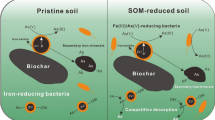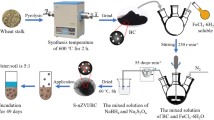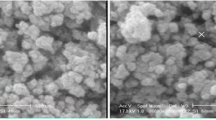Abstract
In this study, the influences of sulfidation on zero-valent iron (ZVI) performance toward As(V) immobilization in soil were systemically investigated. It was found that, compared to unamended ZVI, sulfidated ZVI (S-ZVI) is more favorable to immobilize As(V) in soil and promote the conversion of water soluble As to less mobile Fe-Mn bound As. Specifically, under the optimal S/Fe molar ratio of 0.05, almost all of the leached As could be sequestrated by > 0.5 wt.% S-ZVI within 3 h. Although the presence of HA could decrease the desorption of As from soil, HA inhibited the reactivity of S-ZVI to a greater extent. Column experiments further proved the feasibility of applying S-ZVI on soil As(V) immobilization. More importantly, to achieve a good As retention performance, S-ZVI should be fully mixed with soil or located on the downstream side of As migration. The test simulating the flooding conditions in rice culture revealed there was also a good long-term stability of soil As(V) after S-ZVI remediation, where only 0.7% of As was desorbed after 30 days of incubation. Magnetic separation was employed to separate the immobilized As(V) from soil after S-ZVI amendment, where the separation efficiency was found to be dependent of the iron dosage, liquid to soil ratio, and reaction time. Toxicity characteristic leaching procedure (TCLP) tests revealed that the leachability of As from soil was significantly reduced after the S-ZVI amendment and magnetic separation treatment. All these findings provided some insights into the remediation of As(V)-polluted soil by ZVI.

Similar content being viewed by others
References
Al-Abed S R, Jegadeesan G, Purandare J, Allen D (2007). Arsenic release from iron rich mineral processing waste: Influence of pH and redox potential. Chemosphere, 66(4): 775–782
Anders M W, Bull R J, Cantor K P, Chakraborti D, Chen C J, Deangelo A B (2004). IARC monographs on the evaluation of carcinogenic risks to humans. Lyon: IARC Press
Bae S, Lee W (2014). Influence of riboflavin on nanoscale zero-valent iron reactivity during the degradation of carbon tetrachloride. Environmental Science & Technology, 48(4): 2368–2376
Bang S, Johnson M D, Korfiatis G P, Meng X G (2005). Chemical reactions between arsenic and zero-valent iron in water. Water Research, 39(5): 763–770
Bhattacharjee S, Ghoshal S (2018). Optimal design of sulfidated nanoscale zerovalent iron for enhanced trichloroethene degradation. Environmental Science & Technology, 52(19): 11078–11086
Biterna M, Arditsoglou A, Tsikouras E, Voutsa D (2007). Arsenate removal by zero valent iron: Batch and column tests. Journal of Hazardous Materials, 149(3): 548–552
Buschmann J, Kappeler A, Lindauer U, Kistler D, Berg M, Sigg L (2006). Arsenite and arsenate binding to dissolved humic acids: Influence of pH, type of humic acid, and aluminum. Environmental Science & Technology, 40(19): 6015–6020
Comba S, Di Molfetta A, Sethi R (2011). A comparison between field applications of nano-, micro-, and millimetric zero-valent iron for the remediation of contaminated aquifers. Water, Air, and Soil Pollution, 215(1–4): 595–607
Das H K, Mitra A K, Sengupta P K, Hossain A, Islam F, Rabbani G H (2004). Arsenic concentrations in rice, vegetables, a fish in Bangladesh: A preliminary study. Environment International, 30(3): 383–387
Dong J, Zhao Y S, Zhao R, Zhou R (2010). Effects of pH and particle size on kinetics of nitrobenzene reduction by zero-valent iron. Journal of Environmental Sciences (China), 22(11): 1741–1747
Dou X M, Li R, Zhao B, Liang W Y (2010). Arsenate removal from water by zero-valent iron/activated carbon galvanic couples. Journal of Hazardous Materials, 182(1–3): 108–114
Fan D, Anitori R P, Tebo B M, Tratnyek P G, Lezama Pacheco J S, Kukkadapu R K, Engelhard M H, Bowden M E, Kovarik L, Arey B W (2013). Reductive sequestration of pertechnetate (99TcO4−) by nano zerovalent iron (nZVI) transformed by abiotic sulfide. Environmental Science & Technology, 47(10): 5302–5310
Fan D, Lan Y, Tratnyek P G, Johnson R L, Filip J, O’Carroll D M, Nunez Garcia A, Agrawal A (2017). Sulfidation of iron-based materials: A review of processes and implications for water treatment and remediation. Environmental Science & Technology, 51(22): 13070–13085
Guan X H, Yang H Y, Sun Y K, Qiao J L (2019). Enhanced immobilization of chromium(VI) in soil using sulfidated zero-valent iron. Chemosphere, 228: 370–376
Guo X J, Yang Z, Liu H, Lv X F, Tu Q S, Ren Q D, Xia X H, Jing C Y (2015). Common oxidants activate the reactivity of zero-valent iron (ZVI) and hence remarkably enhance nitrate reduction from water. Separation and Purification Technology, 146: 227–234
Han Y L, Yan W L (2016). Reductive dechlorination of trichloroethene by zero-valent iron nanoparticles: Reactivity enhancement through sulfidation treatment. Environmental Science & Technology, 50(23): 12992–13001
He C S, He D, Collins R N, Garg S, Mu Y, Waite T D (2018). Effects of good’s buffers and pH on the structural transformation of zero valent iron and the oxidative degradation of contaminants. Environmental Science & Technology, 52(3): 1393–1403
He F, Zhao D, Paul C (2010). Field assessment of carboxymethyl cellulose stabilized iron nanoparticles for in situ destruction of chlorinated solvents in source zones. Water Research, 44(7): 2360–2370
Huang S S, Xu C H, Shao Q Q, Wang Y H, Zhang B L, Gao B Y, Zhou W Z, Tratnyek P G (2018). Sulfide-modified zerovalent iron for enhanced antimonite sequestration: Characterization, performance, and reaction mechanisms. Chemical Engineering Journal, 338: 539–547
Jones C A, Inskeep W P, Neuman D R (1997). Arsenic transport in contaminated mine tailings following liming. Journal of Environmental Quality, 26(2): 433–439
Jung H B, Charette M A, Zheng Y (2009). Field, laboratory, and modeling study of reactive transport of groundwater arsenic in a coastal aquifer. Environmental Science & Technology, 43(14): 5333–5338
Kögel-Knabner I, Amelung W, Cao Z H, Fiedler S, Frenzel P, Jahn R, Kalbitz K, Kolbl A, Schloter M (2010). Biogeochemistry of paddy soils. Geoderma, 157(1–2): 1–14
Krol M M, Oleniuk A J, Kocur C M, Sleep B E, Bennett P, Xiong Z, O’Carroll D M (2013). A field-validated model for in situ transport of polymer-stabilized nZVI and implications for subsurface injection. Environmental Science & Technology, 47(13): 7332–7340
Macur R E, Wheeler J T, Mcdermott T R, Inskeep W P (2001). Microbial populations associated with the reduction and enhanced mobilization of arsenic in mine tailings. Environmental Science & Technology, 35(18): 3676–3682
Mak M S H, Rao P H, Lo I M C (2009). Effects of hardness and alkalinity on the removal of arsenic(V) from humic acid-deficient and humic acid-rich groundwater by zero-valent iron. Water Research, 43(17): 4296–4304
O’Carroll D, Sleep B, Krol M, Boparai H, Kocur C (2013). Nanoscale zero valent iron and bimetallic particles for contaminated site remediation. Advances in Water Resources, 51: 104–122
Peng X, Xi B D, Zhao Y, Shi Q T, Meng X G, Mao X H, Jiang Y H, Ma Z F, Tan W B, Liu H L, Gong B (2017). Effect of arsenic on the formation and adsorption property of ferric hydroxide precipitates in ZVI treatment. Environmental Science & Technology, 51(17): 10100–10108
Phenrat T, Hongkumnerd P, Suk-In J, Khum-In V (2019). Nanoscale zerovalent iron particles for magnet-assisted soil washing of cadmium-contaminated paddy soil: Proof of concept. Environmental Chemistry, 16(6): 446–458
Rao P, Mak M S, Liu T, Lai K C, Lo I M (2009). Effects of humic acid on arsenic(V) removal by zero-valent iron from groundwater with special references to corrosion products analyses. Chemosphere, 75(2): 156–162
Redman A D, Macalady D L, Ahmann D (2002). Natural organic matter affects arsenic speciation and sorption onto hematite. Environmental Science & Technology, 36(13): 2889–2896
Su Y M, Adeleye A S, Huang Y X, Zhou X F, Keller A A, Zhang Y L (2016). Direct synthesis of novel and reactive sulfide-modified nano iron through nanoparticle seeding for improved cadmium-contaminated water treatment. Scientific Reports, 6, 24358
Sun Y K, Guan X H, Wang J M, Meng X G, Xu C H, Zhou G M (2014). Effect of weak magnetic field on arsenate and arsenite removal from water by zerovalent iron: An XAFS investigation. Environmental Science & Technology, 48(12): 6850–6858
Tang C L, Huang Y H, Zeng H, Zhang Z Q (2014). Reductive removal of selenate by zero-valent iron: The roles of aqueous Fe2+ and corrosion products, and selenate removal mechanisms. Water Research, 67: 166–174
Tessier A, Campbell P G C, Bisson M (1979). Sequential extraction procedure for the speciation of particulate trace-metals. Analytical Chemistry, 51(7): 844–851
Wang J, Wang P M, Gu Y, Kopittke P M, Zhao F J, Wang P (2019). Iron-manganese (oxyhydro)oxides, rather than oxidation of sulfides, determine mobilization of Cd during soil drainage in paddy soil systems. Environmental Science & Technology, 53(5): 2500–2508
Zavala Y J, Duxbury J M (2008). Arsenic in rice: I. Estimating normal levels of total arsenic in rice grain. Environmental Science & Technology, 42(10): 3856–3860
Zhou Z, Alhadidi Q, Quiñones Deliz K, Yamaguchi Greenslet H, Bonzongo J C (2020). Removal of oxyanion forming elements from contaminated soils through combined sorption onto zero-valent iron (ZVI) and magnetic separation: Arsenic and chromium as case studies. Soil & Sediment Contamination, 29(2): 180–191
Acknowledgements
This work was supported by the National Key Research and Development Program of China (No. 2019YFC1805202) and the National Natural Science Foundation of China (Nos. 21876129 and 51608431).
Author information
Authors and Affiliations
Corresponding author
Additional information
Highlights
• Sulfidation significantly enhanced As(V) immobilization in soil by zerovalent iron.
• S-ZVI promoted the conversion of exchangeable As to less mobile Fe-Mn bound As.
• Column test further confirmed the feasibility of sulfidated ZVI on As retention.
• S-ZVI amendment and magnetic separation markedly reduced TCLP leachability of As.
Electronic supplementary material
Rights and permissions
About this article
Cite this article
Qiao, J., Liu, Y., Yang, H. et al. Remediation of arsenic contaminated soil by sulfidated zero-valent iron. Front. Environ. Sci. Eng. 15, 83 (2021). https://doi.org/10.1007/s11783-020-1377-z
Received:
Revised:
Accepted:
Published:
DOI: https://doi.org/10.1007/s11783-020-1377-z




